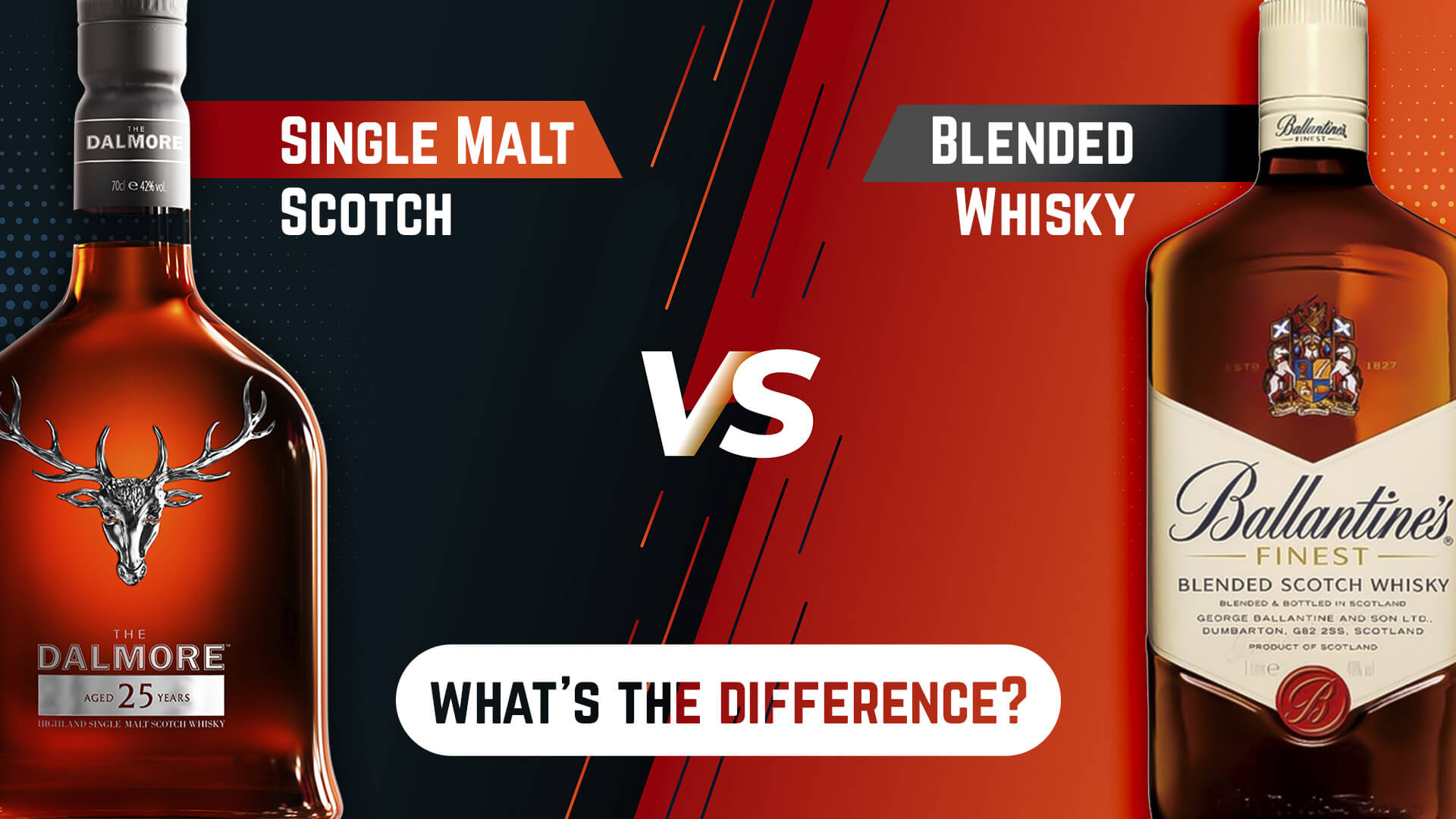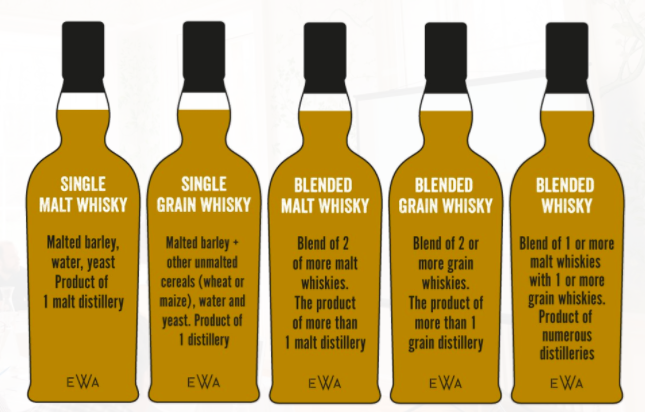Are you a whiskey enthusiast looking to expand your knowledge on different types of whiskey? Well, you've come to the right place! In this article, we will explore the differences between single malt and blended whiskey, two popular categories within the world of whiskey. Whether you're new to the whiskey scene or just curious about the variations in taste and production methods, this article will provide you with all the information you need to know. So sit back, relax, and let's embark on a flavorful journey through the world of whiskey!
:max_bytes(150000):strip_icc()/__opt__aboutcom__coeus__resources__content_migration__serious_eats__drinks.seriouseats.com__images__2012__02__20120209singlemaltvsblendwhisky-deeecdf7b8b94cb38532133b093fca8b.jpg)
Production Process
Ingredients
The production process of both single malt and blended whiskey begins with carefully selected ingredients. However, the main difference lies in the type of ingredients used. Single malt whiskey is made exclusively from malted barley, while blended whiskey combines malted barley with other grains such as corn or wheat. The choice of ingredients greatly influences the flavor and character of the final product.
Mashing
Once the ingredients are selected, the next step in the production process is mashing. This involves grinding the grains and mixing them with hot water to extract the sugars. In the case of single malt whiskey, only malted barley is used in this step. On the other hand, blended whiskey utilizes a combination of malted barley and other grains. The mashing process is crucial for converting the starches in the grains into fermentable sugars.
Fermentation
After the mashing process, the resulting liquid, known as the wort, is transferred to fermentation vessels. Yeast is then added to initiate the fermentation process. During fermentation, yeast converts the sugars in the wort into alcohol, creating a liquid known as "wash." This wash has a low alcohol content and contains a range of flavors that will contribute to the final product.
Distillation
Distillation is a key step in producing whiskey, as it allows the separation of alcohol from the wash. Both single malt and blended whiskey undergo distillation, although the process may vary. Single malt whiskey is usually distilled in pot stills, which result in a heavier and more full-bodied spirit. Blended whiskey, on the other hand, often goes through a continuous column still, which produces a lighter and smoother profile.
Maturation
After distillation, both single malt and blended whiskey are aged in oak barrels for a specific period of time. This maturation process allows the spirit to develop its distinctive flavors and character. Single malt whiskey is typically aged in barrels made from a single type of wood, such as oak, and the aging process contributes to its complexity and depth of flavor. Blended whiskey, on the other hand, may be aged in a combination of different types of barrels, which adds layers of complexity to the final product.
Raw Materials
Single Malt Whiskey
Single malt whiskey is made exclusively from malted barley. This gives it a distinct malty flavor and a rich, full-bodied character. The use of malted barley allows for a wide range of flavors to develop during the mashing, fermentation, and distillation processes. Single malt whiskey is often associated with Scotland, where it originated, but it is now produced in various regions around the world.
Blended Whiskey
Blended whiskey, as the name suggests, is a blend of different types of whiskey. It typically includes a combination of malted barley whiskey and grain whiskey, which is made from other grains such as corn or wheat. The use of a variety of whiskeys in the blend allows for a more balanced and versatile flavor profile. Blended whiskey is often chosen for its smoothness and approachability.

Age Statement
Single Malt Whiskey
Age statements are commonly found on bottles of single malt whiskey. This refers to the number of years the whiskey has been aged in barrels before being bottled. The age statement provides an indication of the maturity and complexity of the whiskey. Older single malts tend to have more developed flavors, with notes of oak, spice, and caramel. However, it's important to note that age is not the only factor determining the quality of a whiskey.
Blended Whiskey
While age statements are not as common in the world of blended whiskey, some brands do include them. The age statement on a bottle of blended whiskey represents the youngest whiskey used in the blend. Blended whiskey often combines younger and older whiskeys to achieve a consistent flavor profile. The blending process allows for a harmonious balance of flavors, regardless of the individual ages of the whiskeys used.
Flavor Profile
Single Malt Whiskey
Single malt whiskey offers a wide range of flavors due to the exclusive use of malted barley. The flavors can vary depending on factors such as the region where the whiskey was produced, the type of oak barrels used for aging, and the length of maturation. Common flavor profiles in single malt whiskey include notes of honey, vanilla, caramel, fruit, and spice. The intensity and complexity of these flavors can differ greatly between different single malts.
Blended Whiskey
Blended whiskey aims to create a balanced and approachable flavor profile. The combination of malted barley whiskey and grain whiskey results in a smoother and milder taste compared to single malt whiskey. The flavor profile of blended whiskey often includes notes of honey, toffee, nuts, and vanilla. The overall flavor experience is usually more gentle and less intense compared to single malt whiskey.

Consistency and Complexity
Single Malt Whiskey
Single malt whiskey is known for its complexity and depth of flavor. Each single malt has its own unique characteristics, influenced by factors such as the region, distillery practices, and maturation process. This diversity can make exploring single malts a fascinating journey, as you discover the distinct flavors and aromas of different expressions. Single malt whiskey enthusiasts appreciate the nuances and complexities that each bottle brings.
Blended Whiskey
Blended whiskey offers a consistent flavor profile, which is a result of the blending process. The objective of blending is to create a harmonious balance of flavors that remains consistent from batch to batch. Blended whiskey often appeals to those who prefer a smoother and more approachable taste. The blending process allows for a controlled and predictable flavor experience, appealing to a wider audience.
Production Regulations
Single Malt Whiskey
The production of single malt whiskey is subject to strict regulations in certain regions, such as Scotland. These regulations dictate the ingredients, production methods, and aging requirements that single malt whiskey must meet in order to be labeled as such. For example, in Scotland, single malt whiskey must be made from 100% malted barley, distilled in pot stills, and aged in oak barrels for at least three years.
Blended Whiskey
Blended whiskey is not subject to the same regulations as single malt whiskey. The blending process allows for more flexibility in terms of ingredients and production methods. However, reputable whiskey brands still adhere to high standards and quality control to ensure a consistent and enjoyable product.

Popularity and Price
Single Malt Whiskey
Single malt whiskey has seen a surge in popularity in recent years, with a growing number of enthusiasts appreciating its unique flavors and rich history. The increasing demand for quality single malts has also led to a wide range of options available in different price ranges. Some single malts command a higher price due to factors such as rarity, age, and reputation of the distillery.
Blended Whiskey
Blended whiskey remains a popular choice for whiskey drinkers around the world. Its smooth and approachable taste appeals to a broader audience, making it a versatile option for various occasions. The price range for blended whiskey can vary significantly, as there are both entry-level blends and premium offerings available.
Pairing and Preferences
Single Malt Whiskey
Single malt whiskey pairs well with a range of flavors and can be enjoyed in various ways. Its complexity and depth of flavor make it suitable for sipping neat or with a few drops of water to enhance the aromas. Additionally, single malt whiskey can be paired with chocolate, cheese, or even a fine cigar to further enhance the tasting experience. Preferences for single malt whiskey often differ among individuals, with some favoring smoky and peaty expressions, while others prefer softer and fruitier profiles.
Blended Whiskey
Blended whiskey's approachable and smooth nature makes it a versatile choice when it comes to pairing. It can be enjoyed neat, on the rocks, or in classic whiskey cocktails. Its milder flavor profile allows it to complement a wide range of dishes, from grilled meats to desserts. The preference for blended whiskey often depends on personal taste, with some individuals favoring its versatility and easy-drinking qualities.

Cultural Significance
Single Malt Whiskey
Single malt whiskey holds a significant cultural and historical significance, especially in Scotland, where it originated. Scotch single malts are renowned worldwide for their quality and tradition. They are often associated with Scottish heritage and craftsmanship. Distilleries in Scotland have been producing single malt whiskey for centuries, with each region offering its own distinct style and flavor profile. Single malt whiskey has become a symbol of Scottish culture and a source of national pride.
Blended Whiskey
Blended whiskey has a cultural significance as well, with its popularity spanning across different countries and regions. In many countries, blended whiskey is the preferred choice for everyday drinking and social gatherings. It has become ingrained in various cultural traditions and has gained recognition for being a versatile and accessible whiskey style.
Market Segmentation
Single Malt Whiskey
The market for single malt whiskey has expanded significantly in recent years, with a growing number of consumers seeking out unique and high-quality expressions. This has led to a wide range of options available, catering to different preferences and budgets. From peaty and smoky Islay malts to fruity and floral Highland malts, there is something for every whiskey enthusiast. The market segmentation for single malt whiskey allows consumers to explore different styles and flavors, further fueling their passion for this particular whiskey category.
Blended Whiskey
Blended whiskey holds a significant market share in the global whiskey industry. Its versatility and accessibility appeal to a broad range of consumers, from novice whiskey drinkers to seasoned connoisseurs. Blended whiskey brands often offer a range of expressions, allowing consumers to choose based on flavor preferences and price points. The market segmentation for blended whiskey ensures that there is a suitable option available for every whiskey lover. Whether it's an entry-level blend or a premium offering, blended whiskey provides a consistent and enjoyable drinking experience.
In conclusion, the difference between single malt and blended whiskey lies in the choice of ingredients, production methods, flavor profiles, and cultural significance. Single malt whiskey, made exclusively from malted barley, offers complexity and diversity in its flavors. Blended whiskey, on the other hand, combines different types of whiskey to create a balanced and approachable taste. Both styles of whiskey have their own merits and appeal to different preferences. Whether you choose to savor the depth of a single malt or enjoy the versatility of a blended whiskey, the world of whiskey offers a rich and diverse experience for every enthusiast.
